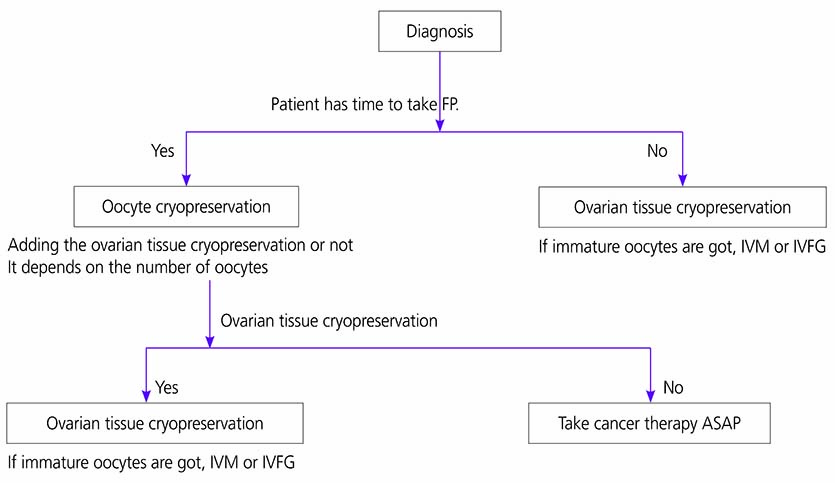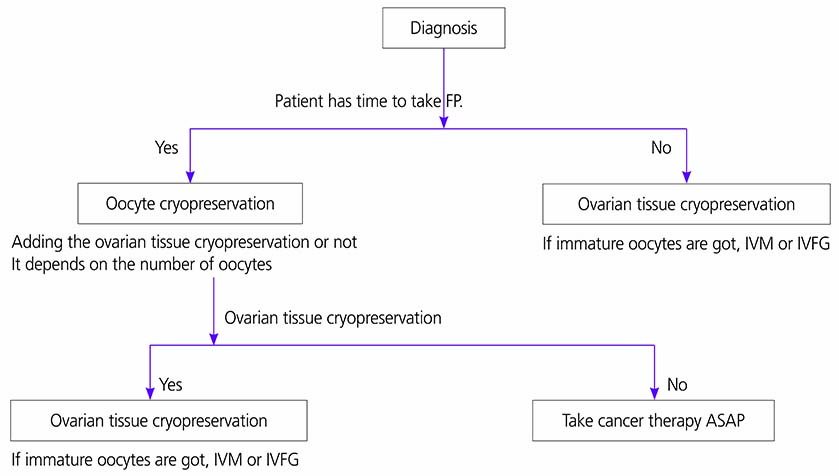Obstet Gynecol Sci.
2018 Jul;61(4):443-452. 10.5468/ogs.2018.61.4.443.
Fertility preservation for adolescent and young adult cancer patients in Japan
- Affiliations
-
- 1Department of Obstetrics and Gynecology, St. Marianna University School of Medicine, Kawasaki, Japan. nao@marianna-u.ac.jp
- KMID: 2439717
- DOI: http://doi.org/10.5468/ogs.2018.61.4.443
Abstract
- Adolescent and young adult (AYA) patients are generally defined as being from 15 to 39 years old. For preservation of fertility in AYA cancer patients, the best-known guideline in this field was released by the American Society of Clinical Oncology (ASCO) in 2006. However, the ASCO guideline is not necessarily applicable to Japanese cancer patients. The Japan Society for Fertility Preservation (JSFP) was formed in 2012, and a system and guideline for fertility preservation in Japanese AYA cancer patients plus children was released in July 2017. According to this guideline, patients should receive psychological and social support from health care providers such as doctors, nurses, psychologists, pharmacists, and social workers. In 2013, the American Society for Reproductive Medicine stated that freezing oocytes is a method that has passed beyond the research stage. However, freezing ovarian tissue is still a research procedure. While slow freezing of ovarian tissue is generally performed, rapid freezing (vitrification) is more popular in Japan. We have developed a new closed technique for ovarian tissue cryopreservation. It has been suggested that optical coherence tomography might be applied clinically to measure the true ovarian reserve and localize follicles in patients undergoing ovarian tissue transplantation. Combining gonadotropin-releasing hormone agonist therapy with anticancer agents might be useful for ovarian protection and it is expected that discussion of such combined treatment will continue in the future. This article outlines practical methods of fertility preservation using assisted reproductive techniques for AYA cancer patients in Japan.
Keyword
MeSH Terms
-
Adolescent*
Antineoplastic Agents
Asian Continental Ancestry Group
Child
Cryopreservation
Fertility Preservation*
Fertility*
Freezing
Gonadotropin-Releasing Hormone
Health Personnel
Humans
Japan*
Medical Oncology
Methods
Oocytes
Ovarian Reserve
Pharmacists
Psychology
Reproductive Medicine
Reproductive Techniques, Assisted
Social Work
Social Workers
Tissue Transplantation
Tomography, Optical Coherence
Transplants
Vitrification
Young Adult*
Antineoplastic Agents
Gonadotropin-Releasing Hormone
Figure
Reference
-
1. Bleyer A, O'Leary M, Barr R, Ries LAG. Cancer epidemiology in older adolescents and young adults 15 to 29 years of age: including SEER incidence and survival: 1975??000. Bethesda (MD): U.S. Department of Health and Human Services, National Institutes of Health;2006.2. Coccia PF, Altman J, Bhatia S, Borinstein SC, Flynn J, George S, et al. Adolescent and young adult oncology. Clinical practice guidelines in oncology. J Natl Compr Canc Netw. 2012; 10:1112–1150.3. SEER cancer statistics review (CSR) 1975??013 [Internet]. Bethesda (MD): National Cancer Institute;2016. cited 2012 Oct 20. Available from: http://seer.cancer.gov/csr/1975_2013/browse_csr.php?sectionSEL=32&pageSEL=sect_32_table.01.html.4. Foundation for Promotion of Cancer Research (JP). Cancer Statistics in Japan 2015 [Internet]. Tokyo: Foundation for Promotion of Cancer Research;2015. cited 2012 Oct 20. Available from: http://ganjoho.jp/reg_stat/statistics/brochure/backnumber/2015_jp.html.5. Lee SJ, Schover LR, Partridge AH, Patrizio P, Wallace WH, Hagerty K, et al. American Society of Clinical Oncology recommendations on fertility preservation in cancer patients. J Clin Oncol. 2006; 24:2917–2931.
Article6. Loren AW, Mangu PB, Beck LN, Brennan L, Magdalinski AJ, Partridge AH, et al. Fertility preservation for patients with cancer: American Society of Clinical Oncology clinical practice guideline update. J Clin Oncol. 2013; 31:2500–2510.
Article7. Japan Society of Clinical Oncology. JSCO clinical practice guidelines 2017 for fertility preservation in childhood, adolescent and young adult cancer patients. Tokyo: Japan Society of Clinical Oncology;2017. in Japanese.8. Practice Committees of American Society for Reproductive Medicine. Society for Assisted Reproductive Technology. Mature oocyte cryopreservation: a guideline. Fertil Steril. 2013; 99:37–43.9. Cakmak H, Katz A, Cedars MI, Rosen MP. Effective method for emergency fertility preservation: random-start controlled ovarian stimulation. Fertil Steril. 2013; 100:1673–1680.
Article10. Reddy J, Turan V, Bedoschi G, Moy F, Oktay K. Triggering final oocyte maturation with gonadotropin-releasing hormone agonist (GnRHa) versus human chorionic gonadotropin (hCG) in breast cancer patients undergoing fertility preservation: an extended experience. J Assist Reprod Genet. 2014; 31:927–932.
Article11. Oktay K, Turan V, Bedoschi G, Pacheco FS, Moy F. Fertility preservation success subsequent to concurrent aromatase inhibitor treatment and ovarian stimulation in women with breast cancer. J Clin Oncol. 2015; 33:2424–2429.
Article12. Japan Society of Obstetrics and Gynecology. Views on unfertilized oocytes, embryos and ovarian tissues freezing and preservation by medical adaptation. Acta Obstet Gynaecol Jpn. 2016; 68:1470–1474.13. Oktay K, Karlikaya G. Ovarian function after transplantation of frozen, banked autologous ovarian tissue. N Engl J Med. 2000; 342:1919.
Article14. Donnez J, Dolmans MM, Demylle D, Jadoul P, Pirard C, Squifflet J, et al. Livebirth after orthotopic transplantation of cryopreserved ovarian tissue. Lancet. 2004; 364:1405–1410.
Article15. von Wolff M, Dittrich R, Liebenthron J, Nawroth F, Schüring AN, Bruckner T, et al. Fertility-preservation counselling and treatment for medical reasons: data from a multinational network of over 5000 women. Reprod Biomed Online. 2015; 31:605–612.
Article16. Practice Committee of American Society for Reproductive Medicine. Ovarian tissue cryopreservation: a committee opinion. Fertil Steril. 2014; 101:1237–1243.17. Jensen AK, Macklon KT, Fedder J, Ernst E, Humaidan P, Andersen CY. 86 successful births and 9 ongoing pregnancies worldwide in women transplanted with frozen-thawed ovarian tissue: focus on birth and perinatal outcome in 40 of these children. J Assist Reprod Genet. 2017; 34:325–336.
Article18. Suzuki N. Ovarian tissue cryopreservation using vitrification and/or in vitro activated technology. Hum Reprod. 2015; 30:2461–2462.19. Suzuki N, Yoshioka N, Takae S, Sugishita Y, Tamura M, Hashimoto S, et al. Successful fertility preservation following ovarian tissue vitrification in patients with primary ovarian insufficiency. Hum Reprod. 2015; 30:608–615.
Article20. Kawamura K, Cheng Y, Suzuki N, Deguchi M, Sato Y, Takae S, et al. Hippo signaling disruption and Akt stimulation of ovarian follicles for infertility treatment. Proc Natl Acad Sci USA. 2013; 110:17474–17479.
Article21. Shi Q, Xie Y, Wang Y, Li S. Vitrification versus slow freezing for human ovarian tissue cryopreservation: a systematic review and meta-anlaysis. Sci Rep. 2017; 7:8538.
Article22. Kawahara T, Sugishita Y, Taylan E, Suzuki N, Moy F, Oktay KH. Vitrification versus slow freezing of human ovarian tissue: a comparison of follicle survival and DNA damage. Fertil Steril. 2017; 108:e56–e57.
Article23. Sugishita Y, Taylan E, Kawahara T, Suzuki N, Oktay KH. Comparison of open and closed devices in human ovarian tissue vitrification. Fertil Steril. 2017; 108:e172–e173.24. Takae S, Tsukada K, Sato Y, Okamoto N, Kawahara T, Suzuki N. Accuracy and safety verification of ovarian reserve assessment technique for ovarian tissue transplantation using optical coherence tomography in mice ovary. Sci Rep. 2017; 7:43550.
Article25. Dolmans MM, Marinescu C, Saussoy P, Van Langendonckt A, Amorim C, Donnez J. Reimplantation of cryopreserved ovarian tissue from patients with acute lymphoblastic leukemia is potentially unsafe. Blood. 2010; 116:2908–2914.
Article26. Greve T, Clasen-Linde E, Andersen MT, Andersen MK, Sørensen SD, Rosendahl M, et al. Cryopreserved ovarian cortex from patients with leukemia in complete remission contains no apparent viable malignant cells. Blood. 2012; 120:4311–4316.
Article27. Dolmans MM, Luyckx V, Donnez J, Andersen CY, Greve T. Risk of transferring malignant cells with transplanted frozen-thawed ovarian tissue. Fertil Steril. 2013; 99:1514–1522.
Article28. Hoekman EJ, Smit VT, Fleming TP, Louwe LA, Fleuren GJ, Hilders CG. Searching for metastases in ovarian tissue before autotransplantation: a tailor-made approach. Fertil Steril. 2015; 103:469–477.29. Donnez J, Dolmans MM, Pellicer A, Diaz-Garcia C, Ernst E, Macklon KT, et al. Fertility preservation for age-related fertility decline. Lancet. 2015; 385:506–507.
Article30. Wallace WH, Smith AG, Kelsey TW, Edgar AE, Anderson RA. Fertility preservation for girls and young women with cancer: population-based validation of criteria for ovarian tissue cryopreservation. Lancet Oncol. 2014; 15:1129–1136.
Article31. Sugishita Y, Hashimoto S, Hoshina M, Kawagoe Y, Yoshioka N, Takae S, et al. Ovarian tissue vitrification: ovarian tissue cryopreservation and transplantation. Ishiyakushuppan. 2017; 7:46–59. (in Japanese).32. Takae S, Sugishita Y, Yoshioka N, Hoshina M, Horage Y, Sato Y, et al. The role of menstrual cycle phase and AMH levels in breast cancer patients whose ovarian tissue was cryopreserved for oncofertility treatment. J Assist Reprod Genet. 2015; 32:305–312.
Article33. Xiao S, Duncan FE, Bai L, Nguyen CT, Shea LD, Woodruff TK. Size-specific follicle selection improves mouse oocyte reproductive outcomes. Reproduction. 2015; 150:183–192.
Article34. Ataya K, Rao LV, Lawrence E, Kimmel R. Luteinizing hormone-releasing hormone agonist inhibits cyclophosphamide-induced ovarian follicular depletion in rhesus monkeys. Biol Reprod. 1995; 52:365–372.35. Del Mastro L, Boni L, Michelotti A, Gamucci T, Olmeo N, Gori S, et al. Effect of the gonadotropin-releasing hormone analogue triptorelin on the occurrence of chemotherapy-induced early menopause in premenopausal women with breast cancer: a randomized trial. JAMA. 2011; 306:269–276.
Article36. Lambertini M, Boni L, Michelotti A, Gamucci T, Scotto T, Gori S, et al. Ovarian suppression with triptorelin during adjuvant breast cancer chemotherapy and long-term ovarian function, pregnancies, and disease-free survival, a randomized clinical trial. JAMA. 2015; 314:2632–2640.37. Munster PN, Moore AP, Ismail-Khan R, Cox CE, Lacevic M, Gross-King M, et al. Randomized trial using gonadotropin-releasing hormone agonist triptorelin for the preservation of ovarian function during (neo)adjuvant chemotherapy for breast cancer. J Clin Oncol. 2012; 30:533–538.
Article38. Gerber B, von Minckwitz G, Stehle H, Reimer T, Felberbaum R, Maass N, et al. Effect of luteinizing hormone-releasing hormone agonist on ovarian function after modern adjuvant breast cancer chemotherapy: the GBG 37 ZORO study. J Clin Oncol. 2011; 29:2334–2341.
Article39. Moore HC, Unger JM, Phillips KA, Boyle F, Hitre E, Porter D, et al. Goserelin for ovarian protection during breast-cancer adjuvant chemotherapy. N Engl J Med. 2015; 372:923–932.
Article40. Demeestere I, Brice P, Peccatori FA, Kentos A, Dupuis J, Zachee P, et al. No evidence for the benefit of gonadotropin-releasing hormone agonist in preserving ovarian function and fertility in lymphoma survivors treated with chemotherapy: final long-term report of a prospective randomized trial. J Clin Oncol. 2016; 34:2568–2574.
Article41. Munhoz RR, Pereira AA, Sasse AD, Hoff PM, Traina TA, Hudis CA, et al. Gonadotropin-releasing hormone agonists for ovarian function preservation in premenopausal women undergoing chemotherapy for early-stage breast cancer: a systematic review and meta-analysis. JAMA Oncol. 2016; 2:65–73.42. Oktay K, Turan V. Failure of ovarian suppression with gonadotropin-releasing hormone analogs to preserve fertility: an assessment based on the quality of evidence. JAMA Oncol. 2016; 2:74–75.43. Coccia PF, Pappo AS, Altman J, Bhatia S, Borinstein SC, Flynn J, et al. Adolescent and young adult oncology, version 2.2014. J Natl Compr Canc Netw. 2014; 12:21–32.
Article44. Moss JL, Choi AW, Fitzgerald Keeter MK, Brannigan RE. Male adolescent fertility preservation. Fertil Steril. 2016; 105:267–273.
Article45. Gupta AA, Donen RM, Sung L, Boydell KM, Lo KC, Stephens D, et al. Testicular biopsy for fertility preservation in prepubertal boys with cancer. Identifying preferences for procedure and reactions to disclosure practices. J Urol. 2016; 196:219–224.
Article46. Long CJ, Ginsberg JP, Kolon TF. Fertility preservation in children and adolescents with cancer. Urology. 2016; 91:190–196.
Article47. Woodruff TK. The emergence of a new interdiscipline: oncofertility. Cancer Treat Res. 2007; 138:3–11.
Article
- Full Text Links
- Actions
-
Cited
- CITED
-
- Close
- Share
- Similar articles
-
- Erratum: Correction of Figure: Fertility preservation for adolescent and young adult cancer patients in Japan
- Cancer and Male Infertility
- Fertility preservation in pediatric and young adult female cancer patients
- Controlled ovarian hyperstimulation for fertility preservation in women with breast cancer: Practical issues
- Practical issues and research trends of oncofertility in gynecologic cancer



